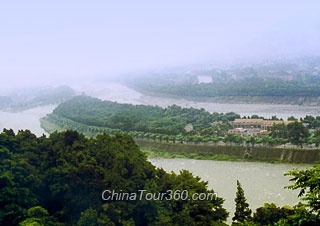 Dujiangyan Irrigation System, Chengdu
Dujiangyan Irrigation System, Chengdu
In ancient China water control projects were considered very important for they not only had a direct influence upon agricultural production, but also provided a convenient method of transportation and communication. Therefore, many famous water control projects were constructed in ancient times, including the Dujiangyan Irrigation System, Zhengguo Canal, and Ling Canal constructed in the Qin Dynasty (221BC - 207BC); Liufu Canal, Bai Canal, and Karez of the Han Dynasty (206BC - 220AD); and the Grand Canal of the Sui Dynasty (581 - 618). Among them, Dujiangyan Irrigation System, Ling Canal, and the Grand Canal were constructed in the Yangtze River basin, while the rest in the Yellow River basin.
![]() Dujiangyan Irrigation System
Dujiangyan Irrigation System
Dujiangyan is located on the Minjiang River to the west of the Chengdu plain, about 56 km (34.8 miles) from Chengdu city. It was constructed by the chief of Shu County (ancient name for the Sichuan area), Li Bing and his son, in the Qin Dynasty. With a history of over 2,000 years, Dujiangyan Irrigation System is the oldest existing water system still in use in China.
The head project is the major part of Dujiangyan, which includes the Fish Mouth Separation Levee, Precious Bottle Neck Drainage Project, and Sand-flying Spillway. On the Yuzui Separation Levee, there is the ancient Anlan Bridge made of bamboo and rattan. The 500-meter (546.8 yards) long bridge is recorded to have been constructed earlier than the Dujiangyan Irrigation System. Baopingkou Drainage Project is not only a significant part of the whole system but also a famous attraction for its charming scenery.
![]() Ling Canal
Ling Canal
Also constructed in the Qin Dynasty, Ling Canal crosses the Xiangjiang River (a distributary of Yangtze River) system and the Pearl River system. It is located in Xing'an County, Guilin, and is considered one of the three largest water control projects of the Qin Dynasty, along with Zhengguo Canal and Dujiangyan Irrigation System.
After the first emperor of the Qin Dynasty unified the country, he tried to conquer Zhejiang, Fujian, Guangdong, and Guangxi areas. The Qin army was victorious but was not able to occupy the Guangdong and Guangxi areas after three years of struggle, because the hilly landform of the Guangzhou area blocked the supply and reinforcements of the Qin army. Therefore, the emperor asked Shi Lu, an official of the Qin Dynasty, to dig a canal through the hills. Shi Lu successfully finished the mission and dug the Ling Canal in Xing'an County, which magically linked the Yangtze River system with Pearl River. The supply and reinforcements of the Qin army were sent to the front lines, and the Qin Dynasty finally made Guangdong and Guangxi areas part of Qin territory.
![]() Grand Canal
Grand Canal
Known as the earliest and longest canal in the world, the Grand Canal stretches for 1,794 km (1,114.7 miles), which is 16 times of the Suez Canal and 33 times of the Panama Canal. The canal flows from north to south through 6 provinces Beijing, Tianjin, Hebei, Shandong, Jiangsu and finally Zhejiang, communicating five water systems, including the Haihe, Yellow, Huaihe, Yangtze, and Qiantang Rivers.
The construction of the Grand Canal occurred in three periods. Fu Chai, the first King of Wu, ordered the Han Channel dug in 486BC during the Spring and Autumn Period (770BC - 476BC). The second period was during the Sui Dynasty. This canal was comprised of the Yongji, Tongji, and Han Channels, and Jiangnan River, stretching from Hebei Province to Zhejiang. The third period was in the Yuan Dynasty (1271 - 1368) when the Grand Canal was extended to Dadu (today's Beijing) and consisted of seven sections, including Tonghui River, North, South, Lu, Middle, Li, and Jiangnan Canals.
The Grand Canal played an important role in the communication between the North and South in ancient China. More and more modern ways of communication have been developed and the canal has long been neglected and in disrepair, so the remaining navigable mileage of the canal is 1,442 km (896 miles), and the whole-year navigable mileage is only 877 km (544.9 miles). However, the Grand Canal is still ranked as one of the greatest canals in the world.








